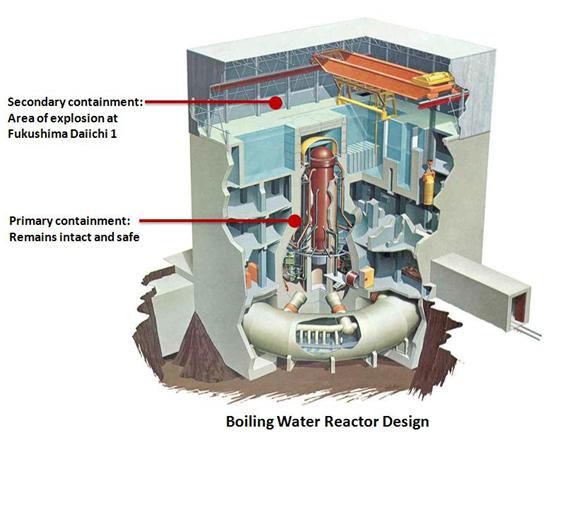Crisis Continues at Nuclear Power Plants
 A (pre-earthquake) aerial view of the Fukushima nuclear power plant. Credit: Tokyo Electric Power Company. |
UPDATE, Monday, March 14
Two hydrogen related explosions have destroyed the secondary containment structures at two reactors at the Fukushima plant, and there have been reports of an explosive sound at a third location. Plant operators are struggling to inject cooling water into the reactor, because of high pressures inside and problems with a pressure release valve. Some of the fuel rods have not been covered completely with water, which could cause them to melt. There have been periodic spikes in radiation, but the primary containment structures seem to be holding, preventing a complete meltdown and the release of large amounts of radiation into the environment.
Saturday, March 12
Radiation levels have risen around a nuclear power plant damaged by an 8.9 magnitude earthquake in Japan, and officials there have ordered the evacuation of an area within a 20 kilometer radius of the plant. The operator of the plant has also reported an explosion in a secondary containment building (see the illustration below), and injuries to four people. The plant operator said the explosion did not affect the main containment area, where the reactor is enclosed. Radiation levels reached 11 millirem, then receded to 7, according to the Nuclear Energy Institute. A chest x-ray measures 8 millirems. The NYTimes is reporting that a major meltdown is not imminent.
Live updates from Japan in English are available here.

Friday, March 11
The massive 8.9 magnitude earthquake in Japan reportedly forced the automatic shutdown of 11 nuclear reactors at four plants in the northeastern part of Japan near the earthquake’s epicenter. There have been no reports of radiation leaks, although Japanese news organizations are reporting that the radiation level within one of the plants is rising, and that radioactive steam may be released to reduce pressure buildup in the facility. [Update: Japan’s nuclear safety agency reportely says the amount of radiation would not threaten human health.]
The earthquake cut off power to at least one of the nuclear plants, the Fukushima plant, and backup generators failed after an hour, forcing local governments to bring in mobile generators. Even after an automatic shutdown, the reactors must be cooled—and without power, cooling water cannot be circulated. [Update: A backup cooling system that uses batteries can temporarily delay overheating.] There have been reports that enough water remains in the reactors for cooling, and to prevent the nuclear fuel from being exposed. The U.S. State Department has said that the U.S. is bringing coolant to the plant, though Jasmina Vujic, a professor of nuclear engineering at the University of California at Berkeley, says it’s not clear why that would be necessary, unless ordinary clean water—which is all that’s needed for coolant–is unavailable. [Update: reports that the U.S. sent coolant may have been incorrect.]
A fire in one of the non-nuclear buildings at another power plant has reportedly been extinguished.
Nuclear power plants in Japan are engineered to withstand “extremely large earthquakes,” and have survived major earthquakes in recent years, Vujic says. She says they have “several layers of safety.” These include concrete walls comprising a total of nearly 20 feet of concrete between the reactor and the outside, and five and a half inches of steel.

The reactors shut down automatically by inserting control rods into the reactor; the rods absorb neutrons and immediately stop the fission chain reactions inside the reactor.
Although no radiation leak has been confirmed, nearly 3,000 people near the Fukushima plant have been evacuated as a precaution.
Keep Reading
Most Popular
Large language models can do jaw-dropping things. But nobody knows exactly why.
And that's a problem. Figuring it out is one of the biggest scientific puzzles of our time and a crucial step towards controlling more powerful future models.
The problem with plug-in hybrids? Their drivers.
Plug-in hybrids are often sold as a transition to EVs, but new data from Europe shows we’re still underestimating the emissions they produce.
Google DeepMind’s new generative model makes Super Mario–like games from scratch
Genie learns how to control games by watching hours and hours of video. It could help train next-gen robots too.
How scientists traced a mysterious covid case back to six toilets
When wastewater surveillance turns into a hunt for a single infected individual, the ethics get tricky.
Stay connected
Get the latest updates from
MIT Technology Review
Discover special offers, top stories, upcoming events, and more.